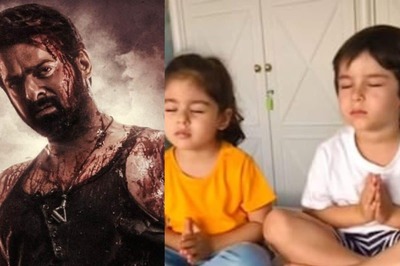
views
The Maha Vikas Aghadi (MVA) experiment imploded in 2022 putting a question mark on the political future of Uddhav Thackeray even as the massive split in the Shiv Sena and its aftermath kept the political pot boiling in Maharashtra throughout the year.
Maharashtra, which was governed by the Congress till 1977-78 and later in the early 90s, has been following coalition politics centred around ‘aghadis’ (coalition fronts of the Congress and Nationalist Congress Party) and ‘yuti’ (Shiv Sena and Bharatiya Janata Party). The upheaval in the Sena resulting in the collapse of the MVA government was the second such instance in the state’s political history.
As a minister in 1978, Sharad Pawar had led a rebellion and toppled the Vasantdada Patil government to become the chief minister at the age of 38.
The era of coalition politics took an unprecedented turn this year when Eknath Shinde walked out with 39 rebel legislators of the Shiv Sena and claimed to be the original Sena. Never before has the political situation in the state, which has 288 MLAs and 48 Lok Sabha MPs, been so complex.
The dust is expected to settle after the elections in civic and local bodies, including the Brihanmumbai Municipal Corporation (BMC), scheduled in 2023. There will be no clarity until the Supreme Court and the Election Commission of India (ECI) take a definite stand on the interpretation of the 10th Schedule of the Constitution which is designed to prevent political defections.
The two-and-half-year-old coalition led by Thackeray, comprising his Sena, NCP and Congress, plunged into a crisis on June 21 when Shinde and his supporters, including a few independent legislators who had earlier sided with the MVA, moved to Surat in the BJP-ruled Gujarat. The group then moved to Guwahati in Assam, another BJP-run state.
On June 29, Uddhav Thackeray resigned as the CM ahead of a floor test. The next day, Shinde took oath as the chief minister and BJP leader Devendra Fadnavis as the deputy CM.
When it was widely anticipated that Fadnavis would return as the chief minister, he announced that he would stay out of the new government and it would be led only by Shinde. But the BJP high command publicly ordered Fadnavis to join the government as the deputy CM.
MVA’s troubles had started mounting on June 10, when the BJP won three of the six seats in the Rajya Sabha elections and a Sena candidate lost. On June 20, of the 10 seats in the Legislative Council elections, Sena and its allies were expected to win six seats, but won only five with the BJP bagging the same number of seats due to cross-voting from the MVA.
Immediately after the Council election results, Shinde and a few Sena MLAs went incommunicado and were later found in a Surat hotel. Shinde was removed as the leader of the Shiv Sena legislature party and a disqualification petition was filed in the Supreme Court, prompting Shinde to challenge the move.
Amid the tussle between the two factions, the ECI has frozen the bow and arrow symbol and the Shiv Sena party name.
The Sena factions also faced off through House rules and the court. After the action against Shinde, the rebel MLAs declared him the leader of the Shiv Sena Legislature Party. The Thackeray faction then filed a petition against the rebel legislators and demanded that Deputy Speaker Narahari Zirwal disqualify 16 MLAs from the Shinde camp. Zirwal first met Shiv Sena leaders before meeting the Advocate General for a legal opinion.
Shinde moved to the Supreme Court to challenge the disqualification plea against 16 of them. The top court directed the deputy speaker to postpone the next hearing to July 11 to give time to the rebel MLAs.
On June 28, Fadnavis met Governor Bhagat Singh Koshyari and demanded a motion of no-confidence against Thackeray. On June 29, Koshiyari ordered that a trust vote be held and the assembly strength of the government be proved by June 30. The Shiv Sena immediately moved the Supreme Court against this order. On the same day, the SC refused to stay the no-confidence motion and ordered it to be conducted the next day. The court said, “The floor of the House is the only way to settle all issues.” A few hours later, Thackeray resigned.
The Supreme Court will take up the clutch of pleas tied to the state’s political crisis on January 13.
The other events that dominated the state’s political landscape were the arrest of NCP leader Nawab Malik in February and Sena’s Sanjay Raut in July on charges of money laundering. After more than 100 days in jail, Raut walked out on bail. While Malik continues to be in jail, his party colleague Anil Deshmukh, who faces corruption allegations, was released on bail on December 28 after 13 months.
After nearly six months, the Shinde government has not gone for cabinet expansion. Ministers of state are yet to be appointed. Including the CM, there are a total of 18 cabinet ministers at present. The Opposition claims that the cabinet expansion is pending because of massive unrest and the government may fall.
The Andheri East assembly bypoll in November marked the first electoral battle after the Shiv Sena split. Late MLA Ramesh Latke’s wife Rutuja won on a Shiv Sena (UBT) ticket.
Another highlight of the year was the Mumbai police not giving permission to the Thackeray faction to hold its annual Dussehra rally at Shivaji Park. The party approached the high court for relief.
On December 17, the MVA held a protest rally in Mumbai against Governor Koshyari for allegedly insulting national icons from the state and the shifting of big-ticket projects like Tata Airbus and Vedanta-Foxconn out of the state. It also criticised the government for staying silent against Karnataka’s provocation in the Maharashtra-Karnataka border row. The rally was seen as a show of strength by the opposition parties.
Tensions flared up when Karnataka Chief Minister Basavaraj Bommai, purportedly through tweets, staked claim over villages from Sangli and Solapur and declared that his government would not yield an inch of its areas to Maharashtra. When Union Home Minister Amit Shah mediated between the two state governments in Delhi, Karnataka claimed that the Twitter account from which the messages were sent was fake.
The Congress’s Bharat Jodo Yatra entered Maharashtra on November 7 and traversed through five districts of the state for 14 days. The party said the response to the yatra was a clear signal that Rahul Gandhi’s march had reenergized the cadre and infused new energy in the organisation.
Read all the Latest Politics News here




















Comments
0 comment